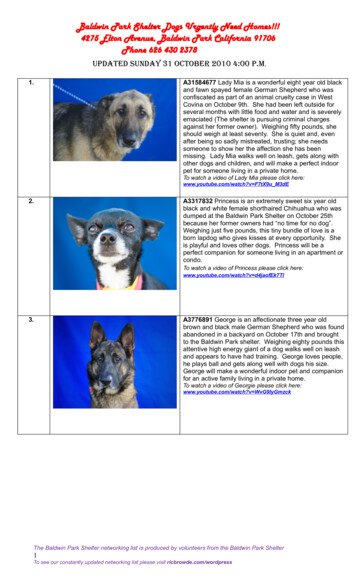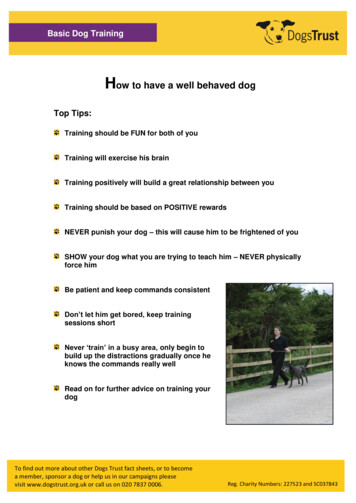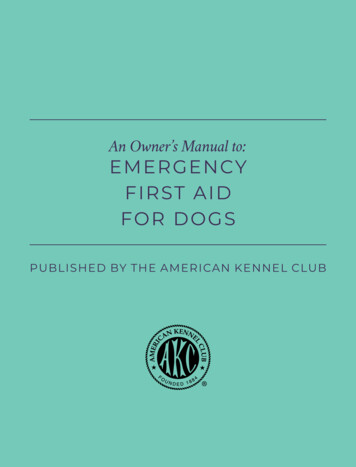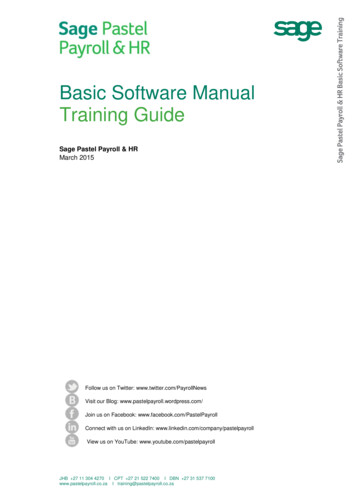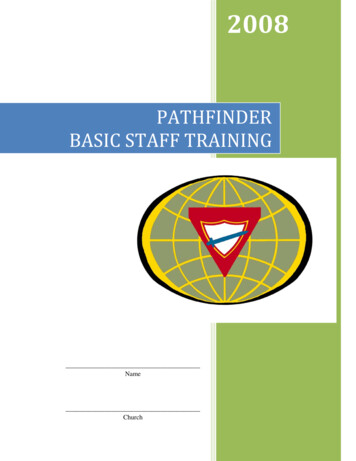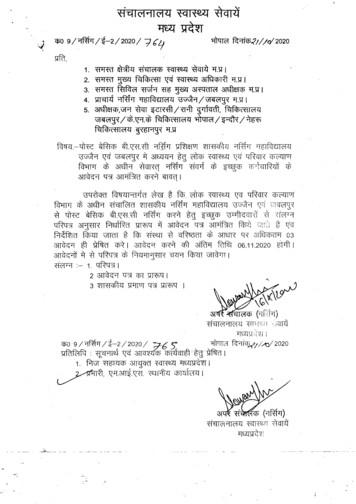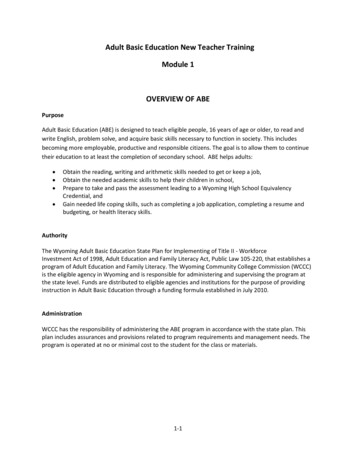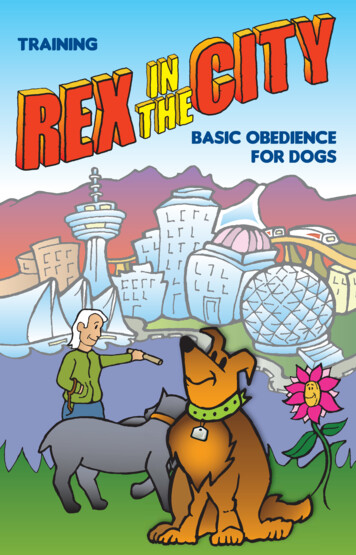
Transcription
TRAININGBASIC OBEDIENCEFOR DOGS
ABOUT THE AUTHORNANCY CLARKEIn addition to her role as Manager of theCity of Vancouver Animal Control Services, Nancyis working toward a PhD as a graduate student inthe Animal Science Department at the Universityof British Columbia. She is researching theenvironmental risk factors for canine aggression.Nancy has a master’s degree in social work but hashad a parallel dog-training career. She trained her firstdog when she was 12 years old and has been trainingprofessionally and providing dog obedience instruction toothers since 1973. Nancy combined both of her professionalinterests under the name Pacific Canine. She offers counsellingand assistance to people living with dogs who have behavioural issues and she providespet-loss counselling. Nancy has also been active in the therapy dog movement, firstas the Provincial Evaluator for the St. John Ambulance Therapy Dog Program, then asthe program’s Provincial Director, and now as an advisor to the National ProfessionalAdvisory Board. For her contribution to the St. John Ambulance Therapy Dog Program,Nancy was nominated and inducted into the Order of St. John.Nancy has varied and extensive dog training experience and has been a competitor innumerous dog sports including: CKC conformation; obedience, tracking and retrievertrials; and Schutzhund. As well, she has dabbled in the sport of canine agility as partof the Agility Association of Canada and in stock-dog training as part of the BC StockDog Association.ABOUT THE VANCOUVER ANIMAL SHELTERThe Vancouver Animal Shelter is operated by the City of Vancouver. The shelter is arefuge for lost or abandoned dogs. Many dogs rescued by the shelter come from unhappysituations. Ever considered adopting? Providing a loving home to a deserving dog canchange his life, and yours! The shelter also administers the City of Vancouver’s doglicensing program and provides information on responsible dog ownership. If you live inVancouver and own a dog that’s older than three months, please buy him a licence. It’shis best chance of being identified and finding his way home to you if he ever gets lost.Vancouver Animal Shelter1280 Raymur AvenueVancouver, BC V6A 3L8604.871.6888vancouveranimalshelter.caThe shelter is open for animal viewing Monday to Friday, 10 am to 8 pm,and Saturdays and Sundays, 10 am to 4 pm.
TRAINING REX IN THE CITYBASIC OBEDIENCE FOR DOGSBY NANCY CLARKETo my dogs, past and present,for all they have taught me.Published by the City of Vancouver.Copyright 2006.ISBN 1-894152-14-X.
PREFACEThis manual will help you teach your dog the basics of obedience. The beginnerlevel exercises will introduce fundamental control commands and give youbasic control of your dog.While the approach I’ve taken in this manual will meet the needs of a widerange of pet owners and their dogs, it’s by no means the only effective one.Nor are the methods the last word in all dog-training issues. If the techniquesin this guide aren’t right for your dog’s particular training needs, ask yourveterinarian to recommend a dog obedience trainer.A well-trained dog makes for a better behaved pet, a better relationshipbetween pet and owner, and a safer city. Be patient with your pooch, andyourself. You’re both on the learning curve. Happy training!Nancy ClarkeNOTE: For simplicity’s sake, with no disrespect to females of any species,in this guide an individual dog is a “he.”2
TABLE OF CONTENTSTABLE OF CONTENTSWhat’s inside . 4Week 1 – Preparations; Rules to train by; Basic dog training theory;Positive and negative reinforcement; Corrections;Hand signals; About your daily practice sessions;Learning problems .5Week 2 – Sit on command; Down on command; Heel on leash .21Week 3 – Sit on command; Down on command; Heel on leash(Change of direction; Right U-turn, Left U-turn);Automatic sit; Stays.26Week 4 – Sit on command; Sit-stay; Down on command;Heel on leash (left and right turns); Come fore;More about the “Front” .34Week 5 – Sit on command; Sit-stay; Return to the dog on the sit-stay;Down on command; Heel on leash; About-turn;Automatic sit; Come; Down-stay .38Week 6 – Sit on command; Sit-stay; Come; Down on command;Heel on leash (change of pace); Down-stay.42Week 7 – Sit on command; Sit-stay; Heel on leash; Come;Formal recall; Down-stay .46Week 8 – Sit-stay; Down-stay; Heel on leash; Formal recall .493
WHAT’S INSIDELesson plansThere is one lesson plan per week for eight weeks. The lessons proceed stepby step in teaching your dog basic obedience, with each lesson building onwhat came before.Optional exercisesYou’ll also find optional exercises that you might want to teach your dog.They’re interesting, but not essential. They’ll be in boxed sections.GETTING STARTEDBefore you start the training program, some preparation is needed.First, read the Week 1 lesson plan, including the “Introduction to dogtraining,” and follow all the instructions. It will give you some usefulbackground and explain some of the theory behind the training. CompletingWeek 1 may not take the whole week, but be sure you have read andunderstood this section before you start training.There is one lesson plan per week for Weeks 2 - 8. Each builds on the skillsof the previous week(s), so it’s important to complete the preceeding lessonbefore advancing to the next.Spend a whole week on each lesson plan. Don’t skip ahead.For best results, train your dog at least 30 minutes each day. Two 15-minutesessions are ideal.Read the whole lesson plan for the week before starting. As you read,visualize what you’re trying to achieve. Try to picture what the exercises willlook like – and how you’ll teach the skill. It’s very helpful to reread individualsections before starting to teach – or even go through the motions withoutthe dog at first.4
LESSON PLANWEEK 1PREPARATIONSGet the right equipmentCollar. A flat nylon or leather collar or a half-check training collar is best.The half-check collar is part nylon fabric and part chain link.A choke chain is not recommended as this type of collar is implicated indoing damage to the esophagus. For this reason and because these collarshave the ability to choke a dog to death, many consider them dangerousand inhumane. Although people do not intend to harm their pets, thesecollars are very easy to misuse. Despite the drawbacks, some peoplewill decide to use this type of collar for training. If you do, it is imperativeto understand how to use it properly – and for this reason, this manualincludes a discussion of the correct placement and the best technique forusing the choke collar (see page 25). However, it bears repeating that this isa dangerous collar. It should never be left on the dog. It should be taken offas soon as the training session is over.Six-foot fabric or leather leash. A chain leash is not acceptable. Buy a leashthat is flexible and you can hold easily. New leather leashes are often stiff;soften them with mineral oil. If you have a small dog, make certain thatthe leash and clasp are appropriate for the dog’s size. Oversized, heavyequipment will tire out a small dog.30-foot long line. Nylon or cotton webbing or polypropylene rope with ahasp on one end. Again, make sure it is an appropriate weight for the dog.Food tidbits. Soft food such as cubes of cheese or bits of hot dog.Toy. A ball or favourite dog toy.Fanny pack. For carrying the food tidbits.Visit your veterinarianMake an appointment to see your veterinarian to make certain that your doghas no health issues that could interfere with training. Deal with any problemsbefore starting any training, and make certain your dog’s vaccinations are upto date.5
Get to know the characteristics of your dog’s breedVisit the library or browse the Internet for information about the specialcharacteristics of your dog’s breed and how you can make use ofthem in training.Learn to hold your leash correctlyPut your right thumb through theloop at the end of the leash. Makea single loop and hold the loop withyour right hand near your waist.This frees up your left hand to petthe dog, give him treats or helpposition him, as necessary.Sometimes when it’snecessary to give a collarcorrection, you may needto hold the leashwith both hands but as soon as the correction iscompleted, free up your left hand again to praiseand encourage the dog.Learn the heel positionBefore practicing any heeling exercises, be certain thatyou completely understand the heel position. Here’s whatit looks like:You and your dog are in correct heel position whenthe dog is no more than four inches from your left side,facing in the same direction as you. Whether thedog is sitting, standing, lying downor moving next to you, he is in properheel position when the area from hishead to his shoulders is in line withyour left hip/leg.6
LESSON PLAN – WEEK 1Before you begin the training exercises,read this introduction to dog training:INTRODUCTION TO DOG TRAININGRules to train byTo make training a safe, productive experience for you and your dog,keep these tips in mind:1. Unless an exercise specificallyrequires that you take the dog offleash, keep your dog on-leash at alltimes while training.2. Don’t allow your dog to sniff, pester orplay with other dogs before or duringtraining sessions.3. Don’t feed your dog for at least fourhours before training.4. Before your training practice sessions,give your dog ample opportunity torelieve himself.5. Take a plastic bag to practice sessions.If your dog defecates, clean it up.6. Practise with your dog only if he iswell rested. Moderate exercise a fewhours before training is fine and mayactually enhance learning for somehigh-energy dogs. But if your dog hasplayed all day or has gone for a longhike, chances are that any practisesessions that day will not be effective.7. Consult this manual before practising.Read and reread instructions. Then goand practise with the dog. Rememberto be patient.8. Practise. Practise. Practise. Dogs learnby repetition. Set aside time each dayto train your dog. At the beginner level,a minimum of 30 minutes of practiceper day is usually needed. It’s alwaysbetter to train for shorter periods, acouple of times a day, especially withyounger or inexperienced dogs.9. Rough or abusive treatment will notserve your training well. If a dogdisobeys your commands, there is abetter than average chance that theproblem is with you, the trainer, notthe dog. Rethink what you’re doing,check the training manual to refreshyour memory and try again.10. Your dog should be clean (brushed)and free of fleas. If your dogis troubled by parasites or isexperiencing skin or other groomingproblems, talk to your veterinarian.Aside from being a health issue, a dogwith such problems will have difficultyconcentrating on the lessons andtraining progress will be slow.11. If you’re training the family pet,one family member should takeresponsibility for training the dogand for practising the lessons eachday. Other family members shouldbecome familiar with commands andexpectations, but it’s usually easieron the dog to have the same familymember act as trainer and take thedog through the course.7
BASIC DOG TRAINING THEORYTeach each new skill or exercise to the dog in three stages:1. Teaching Stage. In this stage, the dog doesn’t understand what you’reasking of him. You’re now teaching the dog, using various aids, to associatea particular word or command with a desired action or behaviour. Duringthis stage, you show the dog what you mean when you say, “Sit.” You usefood and other aids to help the dog understand what you expect when yougive the command.2. Correction Stage. Start correcting as soon as you feel that the dogunderstands your expectation. Keep the food out of sight of the dog in thisstage. If the dog responds correctly when you give the command, give himpraise and a food tidbit, the motivator. If the dog doesn’t give the rightresponse, correct him to get into the desired position. Once he is in thedesired position give praise – and the motivator.3. Proofing Stage. This final stage starts only after the dog consistentlyperforms the exercise correctly and no longer needs correction. The proofingstage seeks to ensure that the dog’s response is reliable in less-than-idealconditions. During this stage, you gradually introduce distractions while thedog works. If he becomes distracted, you teach him to continue to work.Teaching him to obey despite distractions helps make him a safe dog andreliable in any situation.ABOUT TEACHING DESIRED BEHAVIOURDog training is simply shaping the animal’s behaviour to conform to what isacceptable to people.First, we need to clearly define the desired behaviour.Then we break down the behaviour down into small, achievable parts. Thisis known as “task analysis.”Next, we determine what needs to be taught first. Once decided, we beginby teaching this first element and reinforcing it until the dog understands it.Then we move to the next logical element in the sequence, and so on.Each element builds on the previous element(s) until an entire behaviour islearned.There are two kinds of reinforcement: positive and negative. In theteaching stage, we rely exclusively on positive reinforcement. Once we getto the correction stage of any exercise, we combine positive and negativereinforcement.8
LESSON PLAN – WEEK 1Positive reinforcementA positive reinforcer is any thing or any action that the dog enjoys that, by itself, orin combination with others, will increase the likelihood
read this introduction to dog training: 1. Unless an exercise specifi cally requires that you take the dog off-leash, keep your dog on-leash at all times while training. 2. Don’t allow your dog to sniff, pester or play with other dogs before or during training sessions. 3. Don’t feed your dog for at least four hours before training. 4. Before your training practice sessions,File Size: 2MBPage Count: 56

